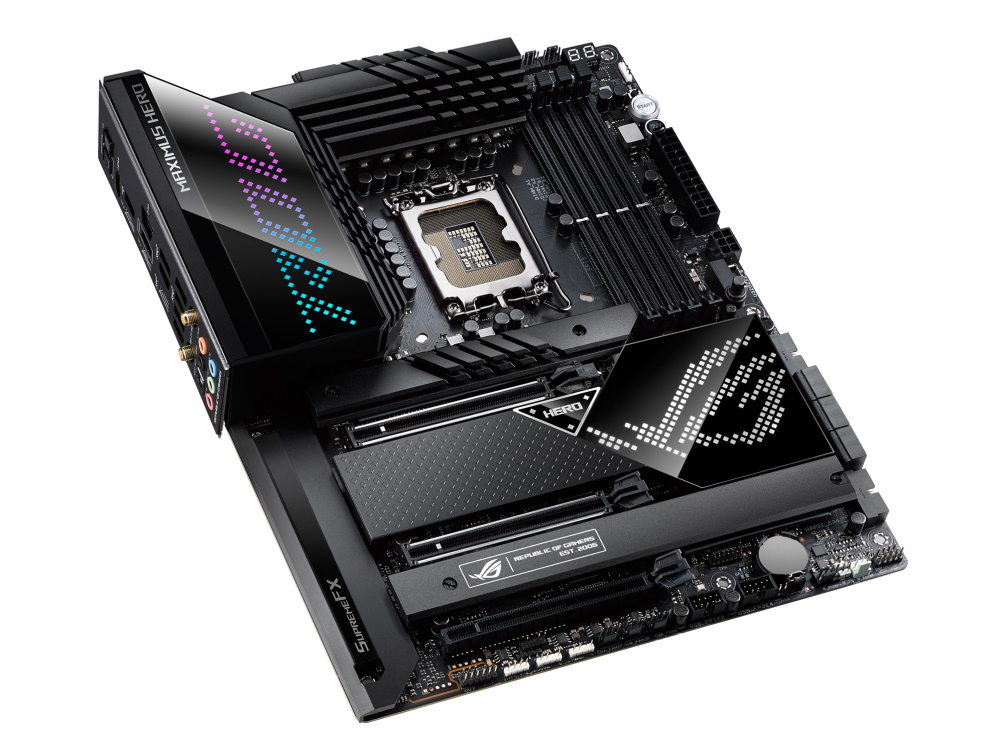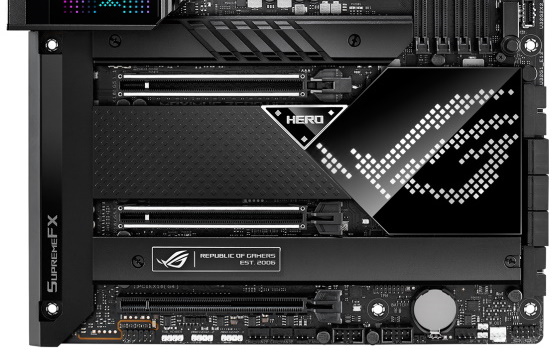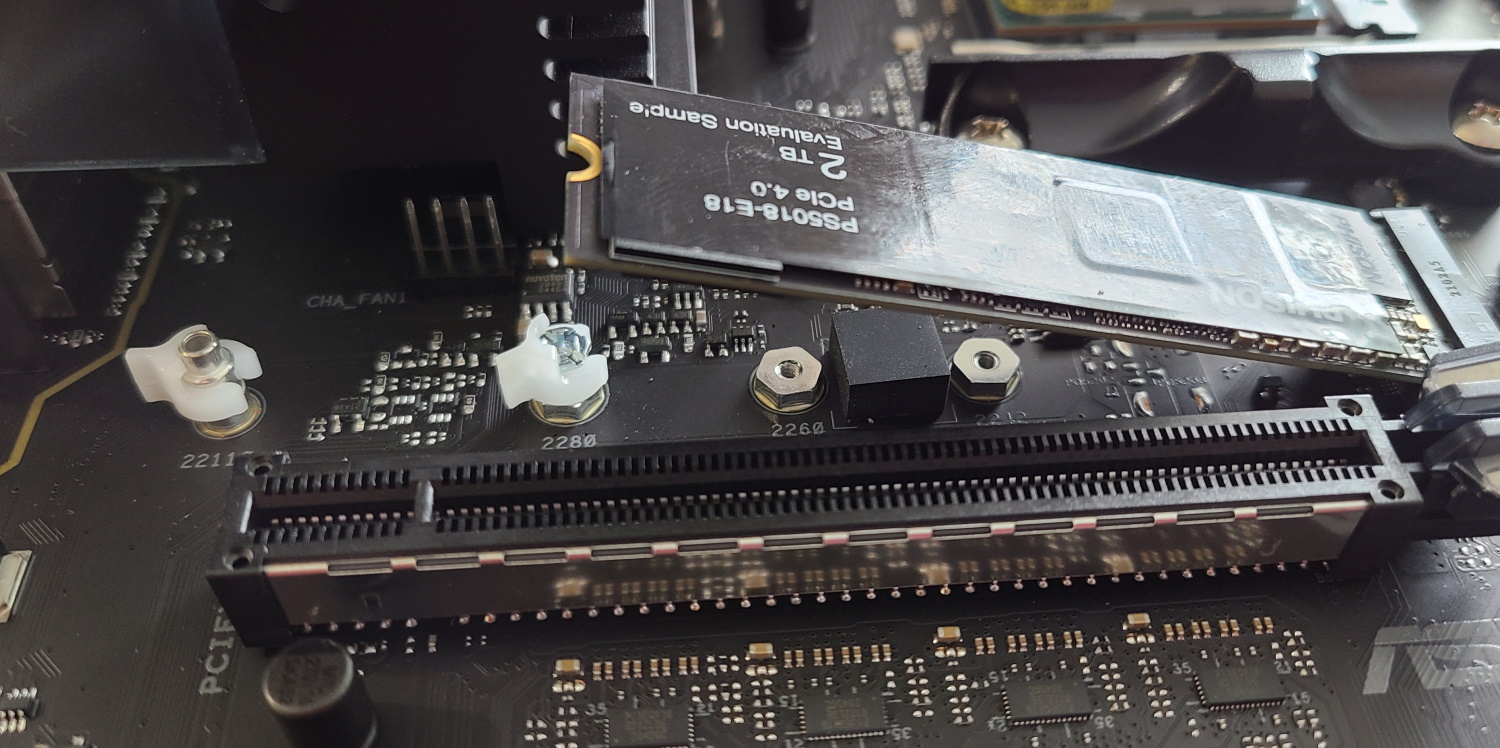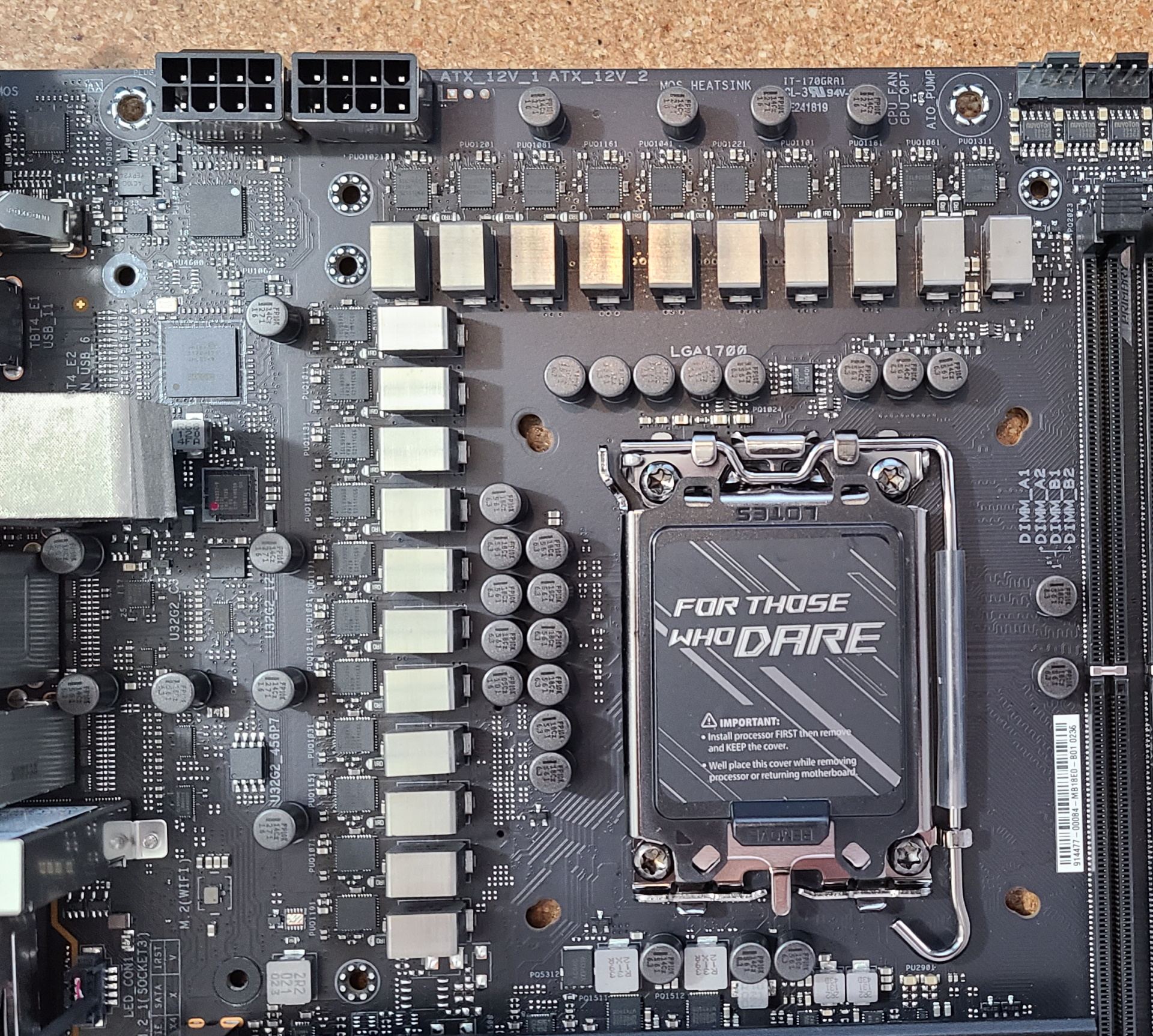Tom's Hardware Verdict
The $599.99 Asus ROG Maximus Z690 Hero comes with five M.2 sockets (one PCIe 5.0 capable), Thunderbolt 4 ports, plenty of fast rear USB connectivity, 2.5 GbE with Wi-Fi 6E and more. If your budget allows and you like the RGB lighting and the design changes, the Z690 Hero is a very good Alder Lake option in its price range.
Pros
- +
+ Five M.2 slots
- +
+ PCIe 5.0 M.2 capable (via add-in-card)
- +
+ Two Thunderbolt 4 Type-C ports
- +
+ M.2 Q-Latch means no tiny screws
- +
+ Push-button GPU release
Cons
- -
Divisive appearance (RGB)
- -
Price
Why you can trust Tom's Hardware
As Intel’s 12th Gen Alder Lake CPUs officially arrive, we’re also getting our first chance to dig into the Z690 motherboard platform, which already sports more than 60 models. First up on our test bench is the ROG Maximus XIV Hero, a premium mid-range board from Asus. We’ll look at performance differences between the last two generations of Intel CPUs, including an i9-10900K and i9-11900K, along with AMD’s current flagship, the Ryzen 5950X. We’ll also cover the performance delta between Windows 10 and Windows 11 using the new Alder Lake-based Intel i9-12900K using our updated testing suite.
Since this is our first Asus Z690 review (and first Z690 review, period), we’ll quickly cover the company’s product stack. Currently, Asus offers 19 Z690 motherboards on their website. From the Halo ROG Maximus Z690 Extreme Glacial product, down to the entry-level Prime Z690-P WIFI D4, there’s a lot to choose from in several shapes, sizes and price points.
The high-end ROG Maximus series returns the Z690 Extreme, Hero, Apex, and Formula. For midrange gaming, there are several ROG Strix boards (Z690-E/F/G/A) along with a Mini ITX Z690-I Gaming WIFI. Two TUF series boards, Gaming Z690-Plus D4 and Plus WIFI D4, make up the budget entries and support DDR4 (as does the Strix Z690-A Gaming WIFI D4). Last is the Z690-Creator WIFI that’s focused on content creators. Prices vary wildly like any product stack, but historically, Asus is competitive in the market but generally priced slightly higher in some categories.
With that out of the way, the Z690 Hero and Core i9-12900K did well in our tests. It’s clear Intel has put in some work (along with Microsoft) to bring you the best experience for this chip in Windows 11. Usually, there isn’t a significant difference between the Windows versions. However, with the new hybrid core configuration in the Alder Lake-based CPUs and Intel’s Thread Director working its magic best in Windows 11, a few tests take quite a hit. Windows 11 performance with the i9-12900K on this board matches or exceeds that of the AMD 5950X on nearly every test. Performance against our other test board was spot on, trading punches with the MSI MEG Z690 Unify.
Read on to see the full results of our updated testing suite, full details of the Asus ROG Maximus Z690 Hero and insight into how the new system performs and overclocks. But first, here’s the full list of specs, straight from Asus.
Specifications - Asus ROG Maximus Z690 Hero
| Socket | LGA 1700 |
| Chipset | Z690 |
| Form Factor | ATX |
| Voltage Regulator | 21 Phase (20+1 90A MOSFETs for Vcore) |
| Video Ports | (1) HDMI (v2.1) |
| (2) Thunderbolt 4 USB Type-C | |
| USB Ports | (2) Thunderbolt 4, Type-C (40 Gbps, up to 5V/12A 60W charging support) |
| (7) USB 3.2 Gen 2, 6x Type-A, 1x Type-C (10 Gbps) | |
| (2) USB 2.0 (480 Mbps) | |
| Network Jacks | (1) 2.5 GbE |
| Audio Jacks | (5) Analog + SPDIF |
| Legacy Ports/Jacks | ✗ |
| Other Ports/Jack | ✗ |
| PCIe x16 | (2) v5.0 (x16, x8/x8) |
| (1) v4.0 (x4) | |
| PCIe x8 | ✗ |
| PCIe x4 | ✗ |
| PCIe x1 | ✗ |
| CrossFire/SLI | ?? |
| DIMM slots | (4) DDR5 6400+(OC), 128GB Capacity |
| M.2 slots | (1) PCIe 4.0 x4 (64 Gbps) / PCIe (up to 110mm) |
| (1) PCIe 3.0 x4 (32 Gbps) / PCIe (up to 80mm) | |
| (1) PCIe 4.0 x4 (64 Gbps) / PCIe + SATA (up to 80mm) | |
| From ROG Hyper M.2 Card | |
| (1) PCIe 5.0 x4 (128 Gbps) / PCIe (up to 110mm) | |
| (1) PCIe 4.0 x4 (64 Gbps) / PCIe (up to 110mm) | |
| Or | |
| (2) PCIe 4.0 x4 (64 Gbps) / PCIe (up to 110mm) | |
| * Supports NVMe RAID 0/1/5 | |
| U.2 Ports | ✗ |
| SATA Ports | (6) SATA3 6 Gbps (Supports RAID0/1/5/10) |
| USB Headers | (1) USB v3.2 Gen 2x2, Type-C (20 Gbps) |
| (2) USB v3.2 Gen 1 (5 Gbps) | |
| (2) USB v2.0 (480 Mbps) | |
| Fan/Pump Headers | (8) 4-Pin (CPU, CPU OPT, AIO, Chassis, W_PUMP) |
| RGB Headers | (3) aRGB (3-pin) |
| (1) AURA RGB (4-pin) | |
| Diagnostics Panel | 2-character debug LED, Post Status Checker (4 LEDs) |
| Internal Button/Switch | Retry, Start, and Flex Key buttons |
| SATA Controllers | ✗ |
| Ethernet Controller(s) | Intel I225-V (2.5 Gbps) |
| Wi-Fi / Bluetooth | Intel AX201 Wi-Fi 6E (2x2 ax, 2.4/5/6 GHz, 160 MHz, BT 5.2) |
| USB Controllers | ✗ |
| HD Audio Codec | RROG Supreme FX (Realtek ALC4082) |
| DDL/DTS Connect | ✗ / DTS Sound Unbound |
| Warranty | 3 Years |
Features - Asus ROG Maximus Z690 Hero
The Maximus Z690 Hero includes quite a bit of extras in the box. You get the basics such as SATA cables and a Wi-Fi antenna, along with a USB drive with drivers. An ROG Hyper M.2 add-in-card also comes included to add additional M.2 sockets. Here’s a full list of included extras.
- ARGB RGB extension cable
- RGB extension cable
- (4) SATA 6Gb/s cables
- ROG Hyper M.2 Card with heatsink
- (2) M.2 screw packages for ROG Hyper M.2 Card
- ASUS Wi-Fi moving antennas
- M.2 Q-Latch package
- (2) M.2 Q-Latch packages for M.2 backplate
- M.2 Rubber Package
- Q-connector
- ROG Graphics card holder
- ROG stickers
- ROG key chain
- ROG thank you card
- USB drive with utilities and drivers
- User Guide



Taking a look at the Z690 Hero for the first time, we’re presented with a matte black PCB and oversized VRM heatsinks that double as the I/O cover. Atop the coveris a large RGB lighting element with a pixelated appearance Asus calls ‘... a microstructural array of light and color.’ This unique design features two RGB patterns, either the ROG letters or the Hero name, along with the ROG symbol. Heatsinks and shrouds cover the bottom portion of the board, matching the black theme. The chipset heatsink sports the same Minecraft-like squares to make up a large ROG symbol. The PCIe and DDR5 DRAM slots are black, with the top two PCIe slots reinforced. Overall, I like the visual changes, but the RGB element above the rear IO takes some getting used to.
Get Tom's Hardware's best news and in-depth reviews, straight to your inbox.
Focusing on the top half of the board, we get a close look at the RGB lighting above the VRM and rear IO. The RGB lights themselves are saturated and bright, and the low-resolution look is unique. Below that are the large and heavy VRM heatsinks connected via an embedded heatpipe. There’s a lot of mass and surface area here, so we expect it to keep the VRMs running within spec.
Just above the VRM heatsinks are two 8-pin EPS connectors to deliver power to the CPU--only one is. Moving right, the socket area is busy with several capacitors dotting the area surrounding the socket itself. You’ll also notice the board has holes to fit both LGA1200 and LGA1700, which is helpful if you don’t have an upgrade kit for your existing cooling solution. Just watch the pressure on the old cooling device as the overall vertical ‘Z’ height is a bit taller on the previous-gen platform (5mm for Rocket Lake, compared to Alder's roughly 4.5mm).
Continuing right, we run into the four DDR5 DRAM slots, capable of supporting up to 128GB of RAM with speeds listed up to DDR5 6400+(OC). With the Alder Lake platform’s maximum rated speed at DDR4 4800, there’s a lot of headroom on paper. We’re running GSkill Trident Z5 DDR5 5600 CL36 sticks on our test system to give you a little idea. So far, it’s been a ‘set XMP and go’ experience across the two motherboards we’ve tested so far.
As the platform matures over time, DDR5 memory speeds will likely increase while timings decrease, but for now, DDR5’s main benefit is lower voltage and power consumption. DDR5 RAM moves the 12V Power Management IC (PMIC) onto the sticks themselves for on-DIMM voltage regulation. The Hero board includes a dedicated circuit that safely circumvents DDR5 memory PMIC restrictions so users can push past the default 1.1-volt limit to increase overclocking headroom--a feature you’ll find on many of the mid-range and greater boards.
Just above the DRAM slots are the first four (of eight) 4-pin fan/pump headers. We don’t have the details on these but expect them all to support both 3-pin DC and 4-pin PWM devices (and Asus Hydranode), with the AIO_PUMP and W_PUMP+ ports running full-speed. Power output is also currently unknown, but if it’s like the Z590 Hero, the CPU and chassis fan headers will support 1A/12W while the W_PUMP+ header will handle up to 3A/36W. Be sure to check the manual though.
Just to the right is the 2-character debug Q-Code, along with the more high-level Q-LED display (4 LEDs). Both of these features prove helpful when troubleshooting POST and boot issues. Between them, you’ll get a good idea of what’s going wrong during POST to fix any boot issues faster.
Turning the corner and moving down the right edge, we run into the first (of four) RGB headers. This one is a 3-pin ARGB, and there are two more ARGB and a 4-pin RGB header on the bottom. Next is a small Retry button (which forces the board to restart). Below that is a large silver Start/Reset button next to the small black (and programmable) Flex button. Continuing down the top-right edge, we run into the 24-pin ATX plug to power the motherboard, along with an additional 6-pin PCIe connector to feed power to the board for high-output charging, up to 60W, via the front panel USB 3.2 Gen 2x2 port that sits just below.
Last but certainly not least is that curious-looking plastic button just above the chipset heatsink. This simple device releases the locking mechanism for the primary video card slot. It’s a mechanical device that works by a wire attached to a lever and the latch. After the GPU gets loaded into the slot, the latch goes up and puts tension on the wire. To unlock it, simply push down on the button and voila, your video card is released. As a motherboard reviewer with large hands, I can’t tell you how convenient this is compared to using a screwdriver (also less risk of scratching and/or damaging your board). That and the fancy new M.2 latches that do away with those tiny screws have to be the most user-friendly features added to motherboards in generations. Kudos, Asus!
IMG - board5 (vrm)
The VRM on the Z690 Hero consists of 20+1 power stages in a teamed configuration. Power is sent from the EPS connectors to a Renesas RAA229131 20-channel controller, then on to the 90A Intersil ISL99390 Smart Power Stages (SPS). This setup yields 1,800 Amps available to the CPU, enough to overclock the power-hungry flagship Intel Core i9-12900K processor we use for testing. You’ll find more (if not all) of the Z690 boards have stepped up their power delivery game because of Alder Lake’s power use.


On the bottom half of the board lives the audio implementation, PCIe slots and the plethora of M.2 storage options available for the Hero, including the PCIe 5.0-capable ROG Hyper M.2 add-in card (AIC). But first, we’ll start on the far left side with audio. Asus uses the SupremeFX ALC4082 (Realtek derivative) codec, which is the flagship part for this generation. Unlike previous generations, the ALC4082 codec uses a USB interface instead of the conventional HDA interface, increasing playback audio resolution to 384 kHz (from 192kHz). The Z690 Hero also uses an ESS SABRE9018Q2C DAC/AMP and premium audio capacitors to deliver high-quality onboard sound.
In the middle of the board lives the PCIe slots. The top two sport the Asus Safeslot reinforcement to protect against shearing and EMI. These are both PCIe 5.0 x16 slots that run as x16 or x8/x8. One of the benefits of PCIe 5.0 is the increased bandwidth. And with that, we’ll see more boards able to bifurcate and split the lanes down to share with other devices (M.2 slots or add-in-cards). For example, when installing the ROG Hyper M.2 card in either PCIe 5.0 slot, the other breaks down to run x8. If you’re wondering whether or not this harms performance, it does not, as the remaining PCIe 5.0 x8 bandwidth is basically equivalent to PCIe 4.0 x16. The bottom full-length slot is fed from the Z690 chipset lanes and runs at a maximum of PCIe 4.0 x4 or x4/x4. For those who are still into multi-GPU technologies, this board supports both AMD Crossfire X and 2-Way Nvidia SLI.
Another byproduct of the additional bandwidth is that there’s plenty of it to go around for M.2 storage. As you may have read in our Z690 Motherboard Overview article, these new Z690 boards typically have an additional M.2 socket or two. Now, even some budget-class offerings include three or even four M.2 sockets. The Z690 Hero supports a total of five M.2 sockets. Three are integrated on the board, while two come from the included ROG Hyper M.2 card. The top board socket supports 110mm modules up to PCIe 4.0 x4 speeds using the CPU lanes. M.2_2 and M.2_3 run up to 80mm drives, with M.2_2 supporting up to PCIe 3.0 x4 and the M.2_3 supporting PCIe 4.0 and SATA modules. At least at this price point, we’re starting to see a migration away from the SATA M.2 modules, with more boards supporting PCIe only. The NVMe drives support RAID 0/1/5 for ultra-fast (or redundant, or both!) storage modes.
So where’s the PCIe 5.0 storage, you ask? You can find it on the ROG Hyper M.2 card. Simply connect the device to the second PCIe slot (PCIEX16(G5)_2), and the Hyper M.2_1 slot on the card supports PCIe 5.0 x4 (128 Gbps). We don’t know of any PCIe 5.0 M.2 drives currently widely available, but when it arrives (likely by CES early next year), you’ll be ready with thisboard. The second slot on the card is also quite fast and checks in at PCIe 4.0 x4.
Looking at the right edge of the board, there are two USB 3.2 Gen1 front-panel ports that round out the USB 3.x connectivity. Nestled between those two plugs are six SATA3 ports. If you’re into RAID, the Z690 Hero runs RAID 0/1/5/10 modes for SATA. As we alluded to earlier, this board does not drop SATA ports for additional bandwidth elsewhere. In short, you can run up to five M.2 modules and six SATA drives concurrently. If you need more storage than that, look into the HEDT platforms--and maybe a second mortgage.
Across the bottom of the board are several headers, including USB ports and RGB. Here’s the complete list, from left to right:
- Front panel audio
- RGB header
- (2) ARGB headers
- (3) 4-pin fan headers
- (2) USB 2.0 headers
- Clear CMOS jumper
- Water Pump+ header
- 2-pin Temperature In/Out headers
- 3-pin Water flow header
- Front panel
Spinning the board around to inspect the rear IO, we see the integrated rear IO plate and a slew of outputs and buttons. From the left, you have BIOS Flashback and Clear CMOS buttons and the HDMI (v1.4) port. Next are two Thunderbolt 4 (USB Type-C) 40 Gbps ports that double as video Displayport 1.4 and Thunderbolt outputs. Just above those are two USB 2.0 ports (the right one is for BIOS Flashback functionality). Just above those is the single Intel 2.5 GbE port. Next are four USB 3.2 Gen1 (10 Gbps) ports and a third USB Type-C port (10 Gbps). You’ll find the two Wi-Fi 6E antenna ports and, finally, the 5-plug plus SPDIF audio stack. With 11 total USB ports available, you’d be hard-pressed to fill them all.
MORE: Best Motherboards
MORE: How To Choose A Motherboard
MORE: All Motherboard Content

Joe Shields is a staff writer at Tom’s Hardware. He reviews motherboards and PC components.
-
litcube Hi. Stupid question: Wouldn't there have been more value in benchmarking different z690 boards with the same CPU/RAM configuration? What useful information could we possibly glean from different CPU, different ram, different boards?Reply -
PapaCrazy $600 is outrageous. DDR5/PCI5 don't justify this kind of gen to gen price increase. Asus seems intent to drive customers to the Aorus Master, which at $470 has even stronger VRM and looks better too.Reply -
laxman10100 Reply
I 100% agree with you. I do, however, find a few useful bits of information in this review. There have been some supposed issues with the Z690 platform and RAM not reaching it's advertised XMP speeds on multiple different boards... So it was nice to see that the GSkill 5600 CL36 RAM was working well on this board (even though it isn't on the QVL list) is good news to me. Thus far, I've only seen reviews/comments on this board and on the MSI boards actually supporting DDR5 CL36 sticks =(PapaCrazy said:$600 is outrageous. DDR5/PCI5 don't justify this kind of gen to gen price increase. Asus seems intent to drive customers to the Aorus Master, which at $470 has even stronger VRM and looks better too.


